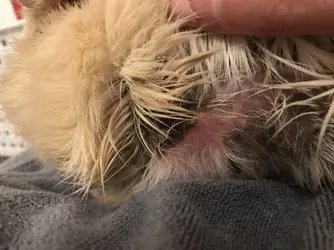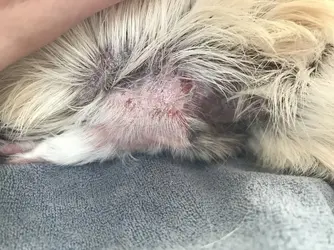@Wiebke have you mentioned in the past that there is a very effective systemic cat antifungal that can be prescribed by vets in the UK (Itrafungol?) Is it still considered a good way to tackle fungal infection? If this poster can phone round and find a vet that has the option of prescribing this treatment for piggies they might make better progress if it turns out to be fungal.
@Lizzieejoyce I'm not a vet, but usually mites/lice (which we've seen a few times) are more easily diagnosed and pretty straightforward to treat whereas generally fungal issues can hang around and be a problem for much longer because of the spores that spread it. Older piggies can certainly be frail and with poorer immune systems so they may suffer from fungal infections when their younger, healthier cage mates do not. I was in this exact position myself with an old girl who had to be treated when my other piggies were fine and I should add did not develop any fungal infection themselves as they reached the ends of their lives in turn. However, it was not ringworm - which is hard to get rid of - but something milder, and she had a shampoo treatment for that (repeated every so many weeks - I forget the regime now) which was effective for her fungus.
Red ears are not a standard flag for mites/lice (there is a common pattern/type of hair loss vets look for as well as debris/egg casings in the fur on certain parts of the body) and I do understand that having a mystery problem that won't go away can make you feel a bit desperate - I have absolutely been there - but if you are going to treat for parasites it should be done properly. For xeno spot-on that is usually THREE treatments of the
correct dose, each TWO weeks apart and EVERY pig treated at the same time which for 4 pigs
is expensive. (There is an alternative of injections as a treatment although this is not something we have ever had prescribed). Also blitzing the cages/fleeces/ houses/tunnels a day or so after each treatment (although I only use hot water and vinegar for this rather than the big guns F10!) Treatment is effective this way. Wrong doses/spacings/repeats or just treating one pig of a group will mean the problem inevitably returning as the mites/lice/eggs have an escape route or an alternative host.
I think with such lovely fluffy piggies you won't have an overnight solution if it turns out to be a fungal issue as the invisible spores will be in the 'environment' for a while. It might not necessarily be ringworm - like my old girl, your Agnes might have something quite easy to shift that her cage-mates don't suffer from although they may still carry it and reinfect her. Even if you are rubbing Canesten cream into a bald patch she can carry the spores all over her fur/friends/owner/cage and you can't coat her in thrush cream - nor would you want to as she would be so miserable. As anyone who's had thrush knows the cream can feel like it is burning as it works on the fungus and make poor piggy cry. If she'd had a fungus-y ear and Canesten had been applied to it that might well explain why it went red. Have a good read of the fungus guides linked in above and if you need to get some of that F10 cleaner for the cage and surrounds I hear Amazon do it and it's very effective. I am not personally familiar with daktarin oral gel but as far as I can tell it's a 'people' antifungal medicine for oral thrush... it is
not a systemic treatment which kills fungus throughout the body, it's just local - like Canesten for inside the mouth - so although it's not toxic (for people at least - I don't know about pigs) I can't see it doing anything for piggy unless piggy has been diagnosed with oral thrush and I'm not sure I'd be happy dosing my piggy with it regularly

If Agnes has a fungal infection these people medicines aren't going to cure it... they haven't so far and I reckon you're wasting your money. But far more dangerous is the next step in thinking... "Well it can't be fungus, because I've treated for fungus and that hasn't worked" I'm not sure you can say that you've had effective treatment for guinea-pig fungal infection so it still can't be ruled out.
By this point there may well be a secondary bacterial infection as piggy will be very itchy and biting/scratching till the skin breaks so you can easily get bacteria in the wound... but using hibiscrub and baytril just won't tackle fungus, or parasites, or even some kinds of bacteria - I don't think that's your primary problem.
Vet prescribed treatments are at a strength that is very effective if used correctly but dangerous if used improperly... that's why they need prescriptions! Some pigs are too young/old/small/pregnant/have medical issues for everypig to get the same treatment without a hands on exam from a vet who hopefully knows what they're doing - and it's true not all have the experience. Off-the-shelf items sometimes contain the same active ingredients but always at
lower doses because they have to account for people who can't interpret the instructions and might therefore apply too much or too frequently, or use them on baby pigs when it says not to. So using off-the-shelf anti-fungal or off-the-shelf ivermectin will only scratch the surface of a problem whereas the correct vet prescription should knock it on the head (at least that's the ideal). Again, perhaps the most dangerous thinking is that, "...it can't be mites/lice(fungus) because we've treated with the ivermectin(daktarin)" when actually it was not an effective treatment. This happens in other countries where you can buy over-the-counter antibiotics... people end up thinking they don't have a bacterial infection because the ABs didn't work without realising it depends on dose/course length/partial resistance/ gram positive or negative type etc (sorry, ex-scientist)...
So I think after you've got the house move out of the way your fastest route to success for poor Agnes is to find another vet and start again. Not what you want to hear I know and I'm really sorry - it's a b*tch of a situation but hopefully you can get on top of it for her sake and yours too x



